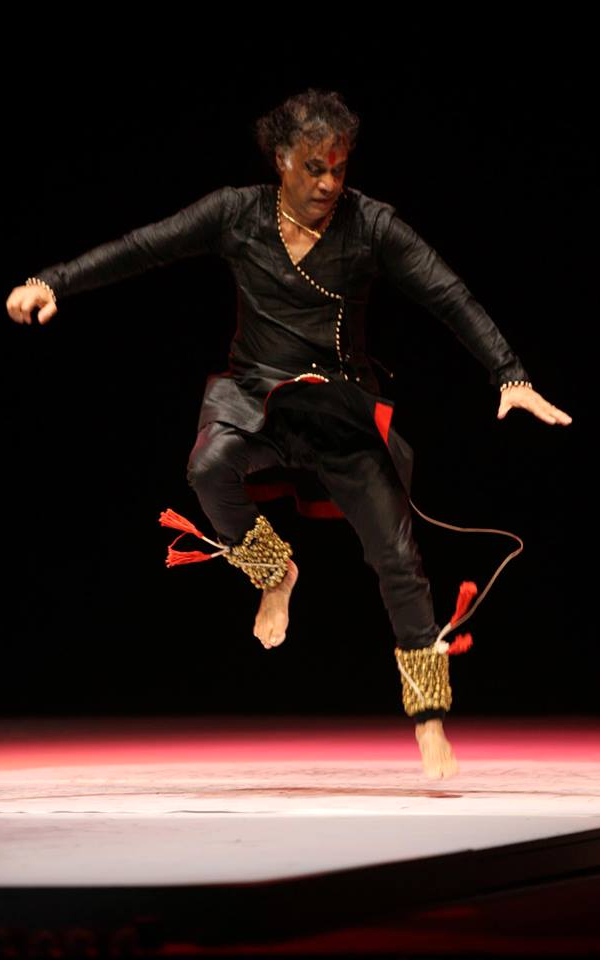Homage to Dance Master Chitresh Das
January, 2015
The world lost a brilliant man this month. I lost a mentor and friend. That man was Chitresh Das, a brilliant Indian dancer. He was only seventy years old, at the peak of his career and creativity. The cause of death was an aortic rupture…I don’t know the details… only that he died quickly without prolonged pain and suffering. His wife and two young daughters that were left behind are the ones who are suffering the most.
I met Chitresh in 1975 when I moved to Marin County, California, to study North Indian classical music at the Ali Akbar College of Music. Renowned music master Ali Akbar Khan had invited Chitresh to come from Calcutta, India, to San Rafael, California, to join the faculty of the college. He was in his late thirties at that time.
Chitresh’s art form was Kathak Dance, one of the major styles of Indian dance (in addition to Bharatanatyam and Odissi dance styles). Kathak dance tells traditional stories, similar in style to the other major styles, using traditional poses and costumes. But Kathak benefited from the Mogul (Moslem) rule of North India, which liberated dance from its traditional storytelling role. Kathak embraced the abstract “art for art’s sake,” giving rise to virtuosic improvisation. Kathak virtuosity is expressed through dazzling footwork, in which the dancer plays the floor like a drum, using his feet like a drummer uses his hands. Chitresh also played the tabla drums quite proficiently. He transferred his knowledge of rhythmic compositions for tabla to his dance performances.
Chitresh told traditional Indian fables from the sacred texts of Hinduism, acting out various parts of the dramatic re-telling, playing male and female roles, and even animal roles when the stories required. One of his most famous dances was to represent a steam-engine-driven train (India’s railroads being perhaps the best remnant of the British colonial period). Using his feet, hands, and story-telling, Chitresh would create a vivid mental image of a train starting up, accelerating, and finally coming to a stop with a final release of steam.
I was fortunate to be part of Chitresh’s dance troup in the early eighties, together with my good buddy Chris Ris on sarode. We played numerous concerts with Chitresh, culminating in my first Indian music tour as part of Chitresh’s troupe in 1982. We performed in Calcutta, New Delhi, Jaipur, and Bombay. It was while in Bombay with Chitresh that I was first introduced to Louiz Banks, the “godfather” of Indian jazz as well as other Mumbai jazz musicians. My friendship with Louiz as well as with other musicians I met while on this tour with Chitresh continues to this day. So to a large extent, Chitresh is responsible for many of the musical connections in Bombay (now Mumbai) which I continue to enjoy.
It was while I was on tour with Mynta in Calcutta five years ago that I last saw Chitresh in concert. His performance was a collaboration with an African-American tap dancer, Jason Samuel Smith, which included a trio of New York jazz musicians as well as several traditional Indian musicians. Jason was literally half Chitresh’s age. Yet they combined their respective art forms seamlessly. It was interesting that during this concert Chitresh declared that the performance was not “fusion”, but rather the pure traditional expressions of the compatible traditions of Kathak and jazz-tap dancing. I understand that for Chitresh, “fusion” was often something practiced by artists incapable of distinguishing themselves through the traditional performance of the art form. I’m sorry that Chitresh never had the opportunity to hear Mynta in concert, since I regard Mynta’s blending of Indian and Western music to be one of the most successful “fusions” on the contemporary music scene.
Chitresh’s sudden death was a tremendous shock to his, family, friends, students, and the Indian artistic communities in India and the US. We lament the loss of what Chitresh might have created in the future. He was always exploring new ways of presenting Kathak dance, most recently with a Flamenco dancer. Retrospectively, his death signifies the loss of a wealth of knowledge, tradition, and inspiration. It will be a challenge to fill the void that he leaves within the Indian dance community. I have seen other excellent Kathak dancers. But in my experience, Chitresh was by far the best. His passing marks the end of an era in which he dominated the Kathak dance world.
Last year while in India, I read the announcement that Chitresh was performing with famous Indian ghatam (clay pot) virtuoso Vikku Vinayakram. Vikku had also performed with Mynta last year, and will be with us again this coming January 31 at a large festival in the city of Pune. (Visit http://www.taalchakra.com). I would have loved to attend that concert, but I had my own concert that night. Starting when I first moved to the San Francisco area forty years ago, I determined to always give priority to my own musical performances, even if it meant missing memorable concerts by the world’s greatest musicians.
I never had the chance to thank Chitresh in person for all that I learned from him, the great experience of performing with him, and the musical connections that he opened for me. I think Chitresh would have be proud to know that his artistry had inspired and enabled my personal artistic journey, just as he did for so many others. And so, in conclusion, I can only say, Thank you Chitresh…thank you thank you!

4 Comments on Homage to Dance Master Chitresh Das
Join the Conversation